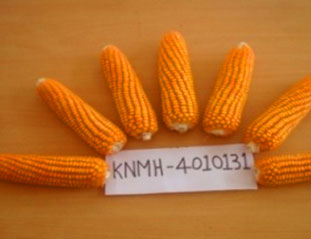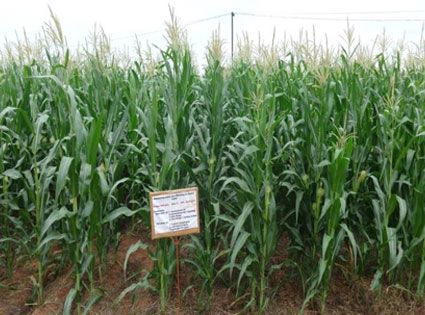Name of centre (Latitude/Longitude): Agricultural Research Station, Karimnagar, PJTSAU
Latitude : 18o 30 N
Longitude :79o 15 E
Elevation (MSL): 259.15 m
Address: Padmanagar, Karimnagar, Telangana, Pin: 505001
Staff details:
| Staff Position | Sanctioned | Staff in position with name | |
| AICRP on maize | |||
| (a) | Scientific staff | 2 | Dr. E. Rajanikanth, Scientist (Agro.) Dr. D. Sravani, Scientist (Pl. Br.) |
| (b) | Technical/ Supporting Staff | 4 | Sri. D. Padma, STA Sri. M. Narsimhulu, AEO Sri. G. Srinivas, AEO Sri. B.Ramesh, Tractor driver |
Mandate:
• To develop medium and early season Maize hybrids for rainfed and irrigated conditions.
• To develop drought tolerant Maize hybrids.
• To develop Maize hybrids resistant to important pests and diseases.
• To develop package of practices for maize and other specialty corns.
• To maintain inbred lines and germplasm of Maize for future use in seed production and breeding programmes.
• Maize parental and hybrid seed production to cater the needs of quality seed to farming community.
• To develop economical and efficient hybrid seed production technology of maize.
• To impart regular training programmes on “Maize Production Technology” to farmers, departmental officers, nodal officers, seed producers of public and private agencies.
Farm area: Total area 19.4 ha, Maize cultivated area: 8 ha

Significant achievements (in bullets with photos) : Karimnagar Makka, (KNMH 4010141), a high yielding (6.5-7.0 t/ha) early maturity maize hybrid from ARS, Karimnagar was notified in the year 2017 for the peninsular zone comprising the states of Telangana, Andhra Pradesh, Maharashtra, Tamil Nadu and Karnataka

KNMH-4010131 (Karimnagar Makka 1), a high yielding (8-8.5 t/ha) medium maturity wilt tolerant hybrid was notified in the year 2016 for the state of telangana.
KNMH-4181, medium maturity hybrid, potential grain yield of 9200 kg/ha with moderate resistance to Maydis leaf blight, Charcoal rot, promoted from NIVT to AVT-I for the north western plain zone comprising the states of Punjab, Haryana, Uttarakhand and New Delhi during the year 2019.
Five Drought tolerant inbred lines KML 29, KDTML 3, KDTML 19, KDTML 82 and KDTML 66 lines developed were registered with National Bureau of Plant Genetic Resources.
Significantly higher maize grain yield and weed control efficiency were recorded with intercultivation thrice and was on par with spraying of Atrazine @ 1kg per acre as pre emergence fb Atrazine @ 1kg per acre or Topremezone @ 30 ml per acre as post emergence herbicides at 20-25 DAS.
Influence of plant density on normal and pop corn hybrids indicated that, optimum plant density of 83,333 plants/ha (60 x 20 cm) realized significantly higher maize grain yields to a tune of 7.3 and 8.7% respectively than grown under a plant density of 1,00,000 plants/ha (50 x 20 cm). Whereas baby corn hybrids recorded 25.4% higher baby corn yield (without husk) at optimum plant density of 1,11,111 plants/ha (45 x 20 cm)) compared to higher plant density of 1,67,667 plants/ha (40 x 15 cm).
Among the nutrient management systems the grain yield of maize hybrids, when applied with SSNM based approach (190-84-143 NPK kg/ha) or soil test based crop response approach (260-94-61 NPK kg/ha) or recommended dose of fertilizer RDF (200-60-50 NPK kg/ha), and 150% RDF (300-90-75 NPK kg/ha) all recorded significantly higher and on par grain yield. Hence, farmers can have cost reduction of Rs. 1678/- per hectare will be saved with RDF application as compared to SSNM or STCR or 150% RDF.
The comparison of different nutrient management practices indicated that farmers can go for recommended dose of fertilizer application to maize crop, which gives cost benefit of Rs.1250/- per hectare as compared to SSNM or farmers practice.
Higher maize grain yield (4435 kg/ha) and BC ratio resulted under zero tillage + mulching when compared to without mulching in conventional tillage and Zero tillage tillage (3977 kg/ha) under rainfed conditions. Significantly lowest grain yield was observed with Conventional tillage (3154 kg/ha). The hydrogel application (@ 2.5 or 5 kg/ha) did not show significant difference on grain yield and yield attributes.

Crop at flowering stage with mulch 
Crop at flowering stage without mulch
Among the different bio-fertilizers application to maize crop, the 30 kg P2O5 /ha + PSB- II (8566 kg/ha) along with recommended dose of N & K has recorded the highest grain yield and it is found to be onpar with all the bio fertilizer treatments along with recommended dose of N & K applied to maize crop.

Significantly higher grain yield and yield attributes were recorded with control (no detopping) and it was on par with detopping (by leaving five leaves above the cob) at 40 days after tasseling in addition green fodder yield of 1.96 t/ha is obtained. Detopping by leaving two, three and four leaves above the cob placement resulted in 22, 18 & 17% yield loss respectively than compared to the control.
There was no significant difference observed among the different nutrient management practices (SSNM, STCR & RDF), plant density (60X 20cm & 50X 20cm) and hybrids (NK 6240 & K 3110) in terms of yield, yield attributes, net returns and B C Ratio. So farmers can go with recommended dose of fertilizers to maize crop.

The influence of planting density at different fertilizer levels in maize crop during kharif indicated significant difference in maize yield at different planting density and the response is non-significant to fertilizer levels application and interaction. Among the fertilizer levels, the grain yield of maize recorded higher at 150% RDN but was found to be on par with 100 or 200% RDN hence farmers can go with recommended dose of fertilizer application. Among the planting density, 75 x 20 cm resulted in significantly higher grain yield (6424 kg/ha) and was on par with 60 x 20 cm (6349 kg/ha). While, the grain yield at 50 x 20 and 45 x 20 cm recorded significantly less yield of 5448 and 6924 kg/ha respectively. The yield attributing characters of cob length, cob girth, kernel number and grain weight per cob recorded significantly higher at 75 x 20 and 60 x 20 cm.
The optimum plant density for getting higher yields in maize crop is 66,667 pl/ha with a spacing of 75X20 cm and is on par with a spacing of 60X20cm i.e.,83,333pl/ha. Among the fertilizer levels, the grain yield of maize recorded higher at 150% RDN but was found to be on par with 100 or 200% RDN hence farmers can go with recommended dose of fertilizer application.
During rabi, in red sandy loam soils, the evaluation of effect of row ratios in seed production of maize hybrid Karimnagar Makka-1 (KNMH-4010131) indicated that, sowing in 5:1 row ratio (Female: Male) has recorded higher F1 grain yield of 2597 kg/ha than compared to existing practice of 4:1 row ratio (2094 kg/ha) indicating 24% increased F1 hybrid yield. An amount of RS. 90540/- will be the benefited due to the increased yield of 24% i.e., 503 Kg/ha, in the seed production without incurring any additional cost. Further this technology will aid to more availability of seed to the farmers.

